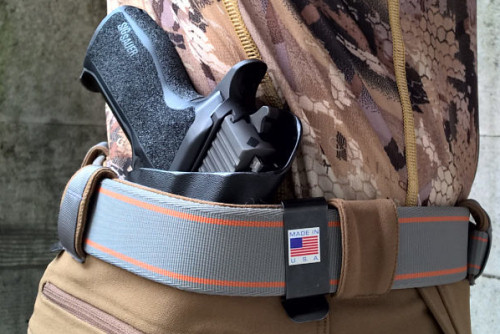Two of the most common carry methods are Inside the Waist Band (IWB) and Outside the Waist Band (OWB), but to keep the conversation pointed toward smaller, compact firearms which can offer deeper concealment, this article will only address Pocket Carry and IWB methods. The main points to consider when searching for your ideal holstering technique are budget, concealability, and access.
Budget
Maybe not the primary factor on everyone’s list, but it’s always a consideration so let’s go ahead and get the budget conversation out of the way. By far, the least expensive way to carry a handgun is going to be Pocket Carry. Mainly because your pocket is already providing the holster, and the gun just needs to be oriented correctly to provide security and quick access. This allows for a minimalist style carry option without much fuss or changes in your normal attire.
On the other hand, IWB holsters can offer additional features and capabilities for how you carry your firearm, but the cost is inevitably higher. There are many different styles of IWB holsters, and there are options out there for most any budget. However, the cost of the holster is not the only thing to consider. Unlike OWB holsters, carrying your handgun IWB is going to add significant bulk to your waistline that your trousers will have to compensate for. In most cases, this is going to lead to having to purchase larger waist size pants which can become quite costly if you plan to carry your handgun every day (unless you wear the same pants every day, which is not advisable).
Concealability
As with most anything in life, there are more decisions that must be made. Before deciding on which method of carry you prefer, you will generally want to decide if you prefer to open carry or concealed carry. In some states, this decision may already be made for you depending on the laws governing civilian handgun specifics. However, in states that allow open carry, you will need to decide just how concealed you would like your handgun to be when carrying. Both Pocket Carry and IWB can provide full or semi concealment for your firearm.
For full concealment with Pocket Carry, you will want a pocket holster. These holsters allow the barrel of your pistol to be inserted firmly while the rest of the holster acts as just a sleeve to cover the trigger and add shape to orient your handgun properly inside your pocket. These type holsters usually have some type of rubber material on the outside that helps to grip the inside of your pocket so the holster stays put when you draw your weapon.
If you are not as concerned about full concealment, a great option to consider for Pocket Carry is a Techna Clip. A true minimalistic carrying experience, this low profile metal clip securely attaches to your handgun and slides over the edge of your pocket as you insert the pistol into your pocket. Other than what little bit of your weapon’s grip protrudes above your pocket, this method of Pocket Carry looks very similar to carrying a knife with a pocket clip.
Despite what you might think, full concealability is possible with an IWB holster, and I don’t just mean pulling your shirt over it either. There are “tuckable” IWB holsters on the market that allow you to fully conceal your weapon by tucking in your shirt over top of the holster. Simply put, this is just a standard IWB holster with a specialized clip that provides a relieved area from the top of your belt loop where your shirt can be tucked in and your handgun to be comfortably concealed. If you are less concerned about full concealability, an IWB holster can be used for open carry or semi-concealed by wearing your shirt outside the holster as well as hidden by a light jacket in colder climates.
“Printing” is one thing to be aware of regardless of whether you choose Pocket Carry or an IWB holster. Either of these methods can cause your handgun to “print.” “Printing” means that the outline of your firearm can easily be identified by someone just by visual observation. Tighter clothes usually provide more susceptibility to “printing.” A thicker holster can sometimes minimize the problem, but that also makes the entire package you are carrying a bit bulkier.
Access
Having quick access to your firearm is another major factor when deciding how you will carry. Both Pocket Carry and IWB holsters can offer quick access, but there are some variables and tradeoffs. In both scenarios, the major tradeoff for accessibility is going to be concealment. The deeper you conceal your firearm, the more difficult it’s going to be to access it.
For Pocket Carry, a pocket holster, which also offers the best concealment option, is going to be the most difficult to draw because your hand has to go completely inside your pocket to retrieve your handgun (though, there are differing opinions about this). A Techna Clip offers a bit more accessibility, but can still be cumbersome vs a standard draw holster. While neither of these are major hindrances, it does equate to a few milli-seconds, in which we all know can be crucial in a threatening situation. Tight clothing can also reduce accessibility for Pocket Carry as the size and snugness of your pockets directly affects the retention of your weapon.
There are tradeoffs with IWB holsters as well, and they are likewise linked to concealment. A “tuckable” IWB holster offer maximum concealment, but in order to gain access to your handgun, you must first untuck your shirt. Again, milli-seconds but still worth mentioning. Out of everything we’ve mentioned here, a normal IWB holster provides the best accessibility to your handgun, but it comes at the sacrifice of deep concealment and can be more costly than other options.
In summary, Pocket Carry and IWB are both great options for everyday carry. Each has its own set of circumstances and tradeoffs that should be evaluated prior to making a decision. As with any piece of self-defense gear, there is no substitute for practice. So, regardless of which method you choose to carry with, be sure to plan out your response and practice regularly so you will prepared if and when the time comes that you need to defend yourself. Good luck!


